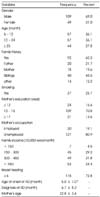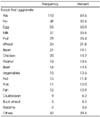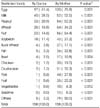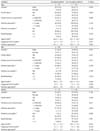Abstract
The prevalence of Atopic Dermatitis (AD), a non-infective chronic inflammatory skin disease, is increasing worldwide. Avoiding the allergen is the basic principle in the treatment of AD. However, when the allergen is food, excessive restriction can lead to nutrition deficiency. The objective of the study was to examine the status of the dietary restriction and compare the caregiver's restriction practice with doctor's recommendation in Korean children with AD. A total of 158 children diagnosed with Atopic Dermatitis were recruited for this study. Information about foods that aggravate AD symptoms and food restriction were collected from the mothers of 158 children aged 6 month-5 year with AD using questionnaires. Food restriction recommendation by doctor was collected through medical chart. McNemar and Margianl homogeneity tests were used to detect a relationship between food restriction recommended by doctor and current practice by mother. There were significant proportion differences of food restriction for each food between by doctor and mother. We found 75.9% of children were avoiding eggs although only 61.4% were recommended for egg restriction by a doctor. Children with restriction of more than 4 kinds of food were 53.2% compared to 13.3% by doctor. Excessive restrictors tended to be younger and diagnosed at younger age. The caregivers of excessive restrictors had trends of "being older" and "having higher income". Avoidance of common foods in children without food allergy could result in malnutrition or impaired growth. Nutrition education is needed for sound practice and nutrition care in children with Atopic Dermatitis as well as interactive communication between caregivers and experts.
Figures and Tables
References
1. Agostoni C, Grandi F, Scaglioni S, Giann ML, Torcoletti M, Radaelli G, Fiocchi A, Riva E. Growth pattern of breastfed and nonbreastfed infants with atopic dermatitis in the first year of life. Pediatrics. 2000. 106(5):E73.
2. Ahn SH, Seo WH, Kim SJ, Hwang SJ, Park HY, Han YS, Chung SJ, Lee HC, Ahn KM, Lee SI. Risk factors of moderate to severe atopic dermatitis in the first 6 months of life. Pediatr Allergy Respir Dis. 2005. 15(3):242–249.
3. Baum WF, Schneyer U, Lantzsch AM, Klöditz E. Delay of growth and development in children with bronchial asthma, atopic dermatitis and allergic rhinitis. Exp Clin Endocrinol Diabetes. 2002. 110:53–59.
4. Chang EY, Chung SW, Lee JH. Mother's experience of caring child with a severe atopic dermatitis. Korean Parent Child Health J. 2006. 9(1):17–32.
5. Cho H, Hong S, Lee S, Yum H. Nutritional status according to sensitized food allergens in children with atopic dermatitis. Allergy Asthma Immunol Res. 2011. 3(1):53–37.
6. Chung SJ, Han YS, Chung SW, Ahn KM, Park HY, Lee SI, Cho YY, Choi HM. Marasmus and kwashiorkor by nutritional ignorance related to vegetarian diet and infants with atopic dermatitis in South Korea. Korean J Nutr. 2004. 37(7):540–549.
7. de Benedictis FM, Franceschini F, Hill D, Naspitz C, Simons FE, Wahn U, Warner JO, de Longueville M. EPAAC Study Group. The allergic sensitization in infants with atopic eczema from different countries. Allergy. 2009. 64(2):295–303.
8. Han YS, Chung SJ, Ahn KM, Lee KS, Choi HM, Lee SI. Sensitization of food allergen in breastfed infant with atopic dermatitis. Korean J Community Nutr. 2005. 10(3):264–270.
9. Hon KL, Leung TF, Kam WY, Lam MC, Fok TF, Ng PC. Dietary restriction and supplementation in children with atopic eczema. Clin Exp Dermatol. 2006. 31(2):187–191.
10. Ibáñez MD, Garde JM. Allergy in patients under fourteen years of age in Alergológica 2005. J Investig Allergol Clin Immunol. 2009. 19:Suppl 2. 61–68.
11. Jin YA, Shim JS, Lee CA, Yum HY, Han MY. The allergen sensitization, family history, diet pattern in atopic dermatitis under 2 years of age. Pediatr Allergy Respir Dis. 2003. 13(3):180–188.
12. Kanny G, Moneret-Vautrin DA, Flabbee J, Beaudouin E, Morisset M, Thevenin F. Population study of food allergy in France. J Allergy Clin Immunol. 2001. 108(1):133–140.
13. Kim BS, Kim YY, Park JH, Kim NI, Choue RW. Effects of medical nutrition therapy on dietary quality, plasma fatty acid composition and immune parameters in atopic dermatitis patients. Korean J Community Nutr. 2008. 13(1):80–90.
14. Lee HY, Lee JR, Roh JY. Epidemiological features of preschool childhood atopic dermatitis in Incheon. Korean J Dermatol. 2009. 47(2):164–171.
15. Mailhol C, Lauwers-Cances V, Rancé F, Paul C, Giordano-Labadie F. Prevalence and risk factors for allergic contact dermatitis to topical treatment in atopic dermatitis: a study in 641 children. Allergy. 2009. 64(5):801–806.
16. Martorell Aragonés A, Flix Toledo R, Martorell Calatayud A, Cerdá Mir JC. Epidemiologic, clinical and socioeconomic factors of atopic dermatitis in Spain: Alergológica-2005. J Investig Allergol Clin Immunol. 2009. 19:Suppl 2. 27–33.
17. Massarano AA, Hollis S, Devlin J, David TJ. Growth in atopic exzema. Arch Dis Child. 1993. 68:677–679.
18. Min SH. Care giver's perceptions and systematic evaluation of korean websites about baby food for atopic dermatitis infants. Korean J Food Cult. 2010. 25(4):357–365.
19. Min SH, Oh HS. A study of the care giver's perception on weaning foods in atopic dermatitis infants. Korean J Food Cult. 2004. 19(4):468–475.
20. Ministry of Health and Welfare. Korea Center for Disease Control and Prevention. Korea National Health and Nutrition Examination Survey (KNHANESIV-3). 2010.
21. Noimark L, Cox HE. Nutritional problems related to food allergy in childhood. Pediatr Allergy Immunol. 2008. 19(2):188–195.
22. Oh JW, Kim KE, Pyun BY, Lee HR, Choung JT, Hong SJ, Park KS, Lee SY, Song SW, Kim CH, Ahn KM, Nam SY, Shon MH, Kim WK, Lee MH, Kwon BC, Choi SY, Lee SY, Lee HB, Lee SI, Lee JS. Nationwide study for epidemiological change of atopic dermatitis in school aged children between 1995 and 2000 and kindergarten aged children in 2003 in Korea. Pediatr Allergy Respir Dis. 2003. 13(4):227–237.
23. Oh JW. Food and atopic dermatitis in children. Safe Food. 2006. 1(2):18–24.
24. Sampson HA, McCaskill CC. Food hypersensitivity and atopic dermatitis: evaluation of 113 patients. J Pediatr. 1985. 107(5):669–675.
25. Sampson HA, Metcalfe DD. Food allergies. JAMA. 1992. 268(20):2840–2844.
26. Sampson HA. The evaluation and management of food allergy in atopic dermatitis. Clin Dermatol. 2003. 21(3):183–192.
27. Sugiyama M, Arakawa H, Ozawa K, Mizuno T, Mochizuki H, Tokuyama K, Morikawa A. Early-life risk factors for occurrence of atopic dermatitis during the first year. Pediatrics. 2007. 119:e716–e723.




 PDF
PDF ePub
ePub Citation
Citation Print
Print







 XML Download
XML Download